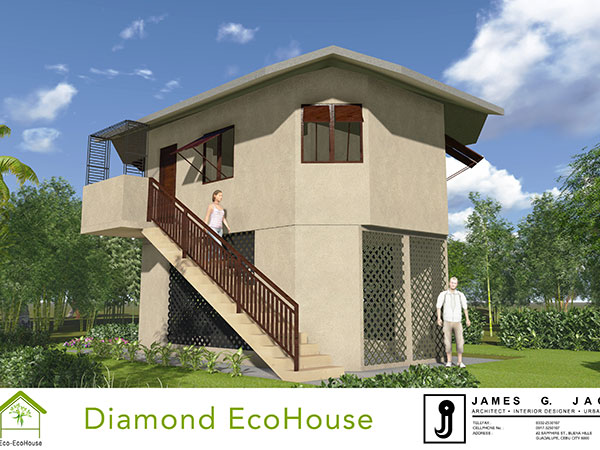For architect James G. Jao, eco doesn’t just stand for ecological, it can can also mean economical.
Armed with a post-graduate degree in city design and social science from the London School of Economics in the UK, Jao returned to the Philippines in 2005 and embarked on his Eco House projects: residential buildings designed with a tropical climate in mind — PVC roof, polystyrene-lined concrete walls to stabilize indoor temperature, and non-toxic paint.
Jao’s iconic designs include the LuzViMinda Eco House (he built a mock-up in the middle of Mall of Asia’s SMX Covention Center during the Construction Show Manila in 2008 and the first commissioned work was finished in Bulusan, Sorsogon 2009).
He also created the Eco Jao Bahay Kubo, a one-bedroom take on the indigenous housing found in the country’s lowlands, updated for the modern times with solar panels and airconditioning, which he presented in 2009.
Jao, who grew up in Sta. Mesa and graduated from the University of Santo Tomas, has established his practice in Cebu City and has several clients from the Visayas and Mindanao.
SEE: I lived here: 3269 Ramon Magsaysay Boulevard, Sta Mesa, Manila
So when he heard about the havoc wreaked by super typhoon Yolanda in November (more than 6,000 confirmed dead and 1,800 people still missing), he designed the Star Rise and Diamond Eco House. Both have a concrete roof and are built to resist climate disruptions like earthquakes and storms. He also has a design for mass housing which Coconuts Manila will report on later.
Hi James, you’ve just designed two eco houses for Tacloban — Star Rise and Diamond. Were these especially commissioned or existing designs?
Neither. I created them to address the need for climate-resilient housing.
So you only created them after Yolanda?
Yes.
They look like sturdier versions of stilt houses.
Definitely these model houses are sturdy. They are built to withstand a storm of 320kph winds and earthquake of 8.0 magnitude on the Richter scale.
So how do you make it climate-resililient?
All walls are reinforced concrete and load bearing, while the roof will be made of thin shell three inches concrete. No concrete hollow blocks will be used. No glass for windows either. I have designed awning windows with basic mechanical and locking mechanism that can withstand the strong winds.
Just like a bahay kubo!
The inspiration is the bahay kubo. The house will be built above ground, the lower space being meant as service area, or one-car garage, just like the vernacular bahay kubo which was used to keep livestock (chicken, pic, goat) and agricultural or fishing tools like araro and banca. The vertical clearnace from the ground to second floor is three meters, while from the second floor to the roof beam is 2.4meters height. The roof height is two meters.
What’s it like inside?
At ground level the footprint of Star Rise is 29sqm and at the second level is 36sqm, while the Diamond has on the ground 34sqm and on the second floor 36sqm. Both have, on the second floor, the stairs landing with a bench, open plan living, dining and kitchen area, and two bedrooms: master and children’s.
How many people can live here?
The house is ideal for one family, but it can be made into a duplex wherein two units will be built side by side with a shared wall, but one four-pitched roof.
This design is for the private sector — have you estimated how much it will cost?
This design can be made available under the Economic Housing category by the NHA-National Housing Authority. Definitely it is not low-cost, but this must be built on a mass housing scale instead of individual.
How long will one unit take to build?
One unit can built in 30 days and yes, there are interested private individuals and we are already identifying sites were we can build multiple units by cluster. In January we wil start the Eco-EcoHouse. Also I am using the same model for a mountain resort in Bulusan, Sorsogon, a one-level cabana and a two-level villa, exactly the same footprint of the two models but with different room configurations.
Why is it called the Eco-Eco House?
ECOlogically sustainable-and climate resilient, ECOnomically affordable.




